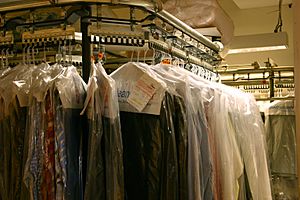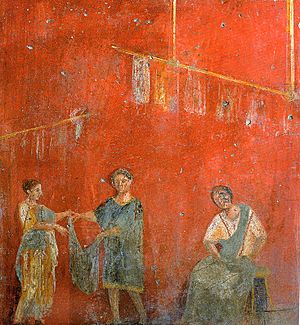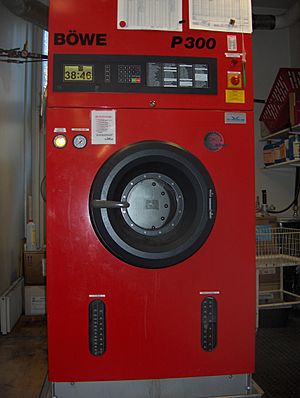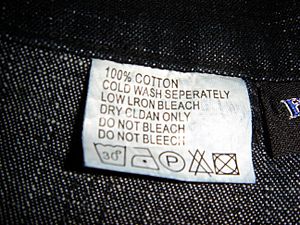Dry cleaning facts for kids
Dry cleaning is a special way to clean clothes and fabrics using a chemical liquid called a solvent instead of water. The most common solvent used is called tetrachloroethylene, or "perc" for short. People often choose dry cleaning for delicate clothes that might get damaged by regular washing with water. It also saves effort compared to hand washing.
Contents
History of Dry Cleaning
Long ago, in the Roman Empire, people used chemicals like ammonia (from urine!) and a special clay called fuller's earth to clean their wool clothes. These cleaning shops, called fullonicae, were very popular. They even collected urine from public bathrooms! The workers in these shops made good money, and the government even taxed the collection of urine.
Modern dry cleaning uses solvents that don't mix with water to remove dirt and stains. The idea for modern dry cleaning came about in the mid-1800s. A French dye-works owner named Jean Baptiste Jolly noticed that his tablecloth looked cleaner after his maid accidentally spilled kerosene on it. This gave him the idea to start a service cleaning clothes this way, which he called "dry cleaning."
Early dry cleaners used liquids like gasoline and kerosene. But these were very flammable and caused many fires and explosions. Because of this, governments started to control dry cleaning businesses. A dry cleaner from Atlanta, William Joseph Stoddard, even developed a slightly safer solvent called Stoddard solvent.
After World War I, dry cleaners started using chlorinated solvents. These were much less flammable and cleaned better. By the 1930s, tetrachloroethylene (perc) became the top choice. It cleaned well, was stable, didn't catch fire easily, and was gentle on most clothes. However, perc was later found to possibly cause cancer, so rules were made to reduce its release into the air. Today, the dry cleaning industry is trying to use other chemicals or methods instead of perc.
In the past, the actual cleaning was done in big factories. Shops would collect clothes from customers, send them to the factory, and then customers would pick them up later. This was because of the fire risk and dangerous fumes. Back then, dry cleaning machines were "vented," meaning their fumes went out into the air, just like a clothes dryer. This caused pollution and wasted a lot of the cleaning solvent. Now, most dry cleaning machines are fully enclosed. This means no solvent fumes escape into the air. The solvent is recovered, cleaned, and reused, which is much better for the environment.
How Dry Cleaning Works
A dry cleaning machine looks a bit like a large washing machine and clothes dryer combined. Clothes are placed inside a spinning drum, which is inside another shell that holds the cleaning solvent. These machines can clean between 10 and 40 kilograms (20 to 80 pounds) of clothes at once.
During the wash cycle, the drum fills about one-third with solvent and starts to spin, moving the clothes around. The solvent is kept at about 30 degrees Celsius (86 degrees Fahrenheit) so it doesn't harm the clothes. While washing, the solvent is constantly filtered and sent back into the drum. After washing, the dirty solvent is sent to a special unit that cleans it through a process called distillation. This process removes dirt and water, so the clean solvent can be reused.
Before clothes go into the machine, workers carefully check them. They look for things like plastic pens, which would melt in the solvent and damage clothes. They also check for loose dyes, especially red ones, which can bleed and stain other clothes. Red items are often cleaned separately. Fasteners, like decorative buttons or beads, might need to be removed or protected if they can't handle the cleaning process. Fragile items, like feather bedspreads, are put into a loose mesh bag for protection.
Many people think dry cleaning removes all stains, but that's not true. Some stains need special treatment with other liquids or steam before or after dry cleaning. Also, clothes that have been dirty for a long time, especially light-colored natural fibers like wool or silk, might not get back their original color and texture.
The main difference between washing with water and dry cleaning is the type of solvent. Water is a "polar" solvent, meaning it mixes well with certain things. Dry cleaning uses a "non-polar" solvent, which works differently.
A typical wash cycle lasts 8 to 15 minutes. In the first few minutes, dirt that dissolves in the solvent comes off, along with loose dirt. It takes longer to remove tougher, ground-in dirt. Machines using hydrocarbon solvents need a longer wash cycle, about 25 minutes, because they work slower. Sometimes, a special "soap" is added to the solvent to help clean better.
After the wash, the machine does a rinse cycle with fresh, clean solvent. This helps prevent any leftover dirt particles from settling back onto the clothes.
Next comes the extraction process. The solvent is drained, and the drum spins very fast (350 to 450 rotations per minute). This spinning removes most of the solvent from the clothes. Modern machines can recover almost all (99.99%) of the solvent for reuse. The cleaning is always done at normal temperatures; the solvent is never heated during the cleaning process.
Finally, the drying cycle begins. The clothes are tumbled in warm air (around 60-63°C or 140-145°F). This warm air makes any remaining solvent evaporate. The air temperature is carefully controlled to protect the clothes. The warm air then goes through a cooling unit, where the solvent vapor turns back into liquid and is returned to the clean solvent tank. Modern machines use a "closed-loop" system, meaning the air is reheated and reused. This helps recover a lot of solvent and reduces air pollution.
After drying, a deodorizing cycle cools the clothes and removes even more solvent by circulating cool outside air through them. This air then passes through a filter to catch any last solvent vapors. Once this cycle is done, the clothes are clean and ready to be pressed.
It's important to know that dry cleaning doesn't remove all the solvent. Small amounts of the solvent can still be found in clothes, especially wool.
Cleaning the Solvent
The solvent used for cleaning goes through several steps to get clean again before it's reused. First, it passes through a "button trap" to catch small items like lint, buttons, or coins.
Over time, a layer of dirt called "muck" builds up on the lint filter. This muck is regularly removed and processed to get any trapped solvent out of it. Many machines use special filters that spin the muck off.
After the lint filter, the solvent goes through another filter made of special clays and charcoal. This filter removes tiny dirt particles, leftover residues, and dyes. Finally, a "polishing filter" catches any remaining dirt. The clean solvent is then ready to be used again.
Small amounts of detergent (about 0.5% to 1.5%) are added to the solvent to help it clean better. These detergents help dissolve stains that mix with water and stop dirt from settling back onto the clothes.
Because dry cleaning doesn't remove water-based stains very well, and because not all solvent is recovered, another method called wet cleaning has become popular. Wet cleaning uses water and special soaps, along with computer-controlled washers and dryers, to clean clothes. It's like a very advanced cold-water wash.
Dry Cleaning Symbols
Clothing labels have special symbols that tell you how to clean them. The international symbol for dry cleaning is a circle.
- A circle with a letter P inside means it should be dry cleaned with perchloroethylene solvent.
- A circle with a letter F inside means it should be dry cleaned with a hydrocarbon solvent.
- A bar underneath the circle means only a mild cleaning process should be used.
- A crossed-out empty circle means the clothes should not be dry cleaned at all.
Dry Cleaning Waste
Dry cleaning creates some waste materials.
- Cooked muck is the leftover material from cleaning the solvent. It contains solvent, filter material, dirt, and dyes. This is considered a hazardous waste and must be thrown away according to strict rules.
- Sludge is another waste material from the bottom of the cleaning machines. It also contains solvent, water, and dirt. This is also a hazardous waste.
Environment and Solvents
Perc (perchloroethylene) is considered a hazardous air contaminant by the United States Environmental Protection Agency. This means it can harm the environment and people if not handled carefully. Dry cleaners using perc must take special steps to prevent it from getting into drinking water or the air. In California, perc was declared a toxic chemical in 1991, and its use will become illegal in that state in 2023.
Scientists and companies are looking for safer alternatives to perc. One option is using liquid CO2. It avoids the toxic risks of perc, but it might not clean some types of dirt as well.
Different Solvents Used Today
Here are some of the modern solvents used in dry cleaning:
- Glycol ethers (like Rynex or Solvair) — These are often better for the environment and can clean some stains even better than perc. They are not a fire hazard.
- Hydrocarbon solvents (like DF-2000 or EcoSolv) — These are similar to the older petroleum-based solvents but are safer. They are less strong than perc, so clothes need to be cleaned for a longer time. They are flammable but safe when used correctly.
- Liquid silicone (D5) — This solvent is very gentle on clothes and doesn't cause colors to fade. It's much better for the environment and breaks down quickly into harmless substances. However, it can be more expensive to use.
- Perchloroethylene (perc) — This has been used since the 1940s and is still the most common. It's a strong cleaner but can sometimes cause colors to bleed or damage delicate decorations on clothes. It's good for oil-based stains and is not flammable.
- Liquid CO2 — This method is very environmentally friendly because carbon dioxide is almost non-toxic and doesn't stay in clothes or the environment. The machines are expensive, so not all cleaners have them. Some cleaners use this for fire- and water-damaged items because it's good at removing soot and odors.
- Wet cleaning — This system uses water and special soaps that break down naturally. Computer-controlled machines make sure clothes keep their size and shape. Wet cleaning can safely clean many items that say "dry clean only," including leather, suede, and silk.
Home Dry Cleaning
There are products you can buy, like Procter & Gamble's Dryel, that let you do some parts of the dry cleaning process at home using your regular laundry machine. These aren't a full professional dry cleaning, but they can be convenient for certain types of clothes.
Images for kids
See also
 In Spanish: Limpieza en seco para niños
In Spanish: Limpieza en seco para niños








